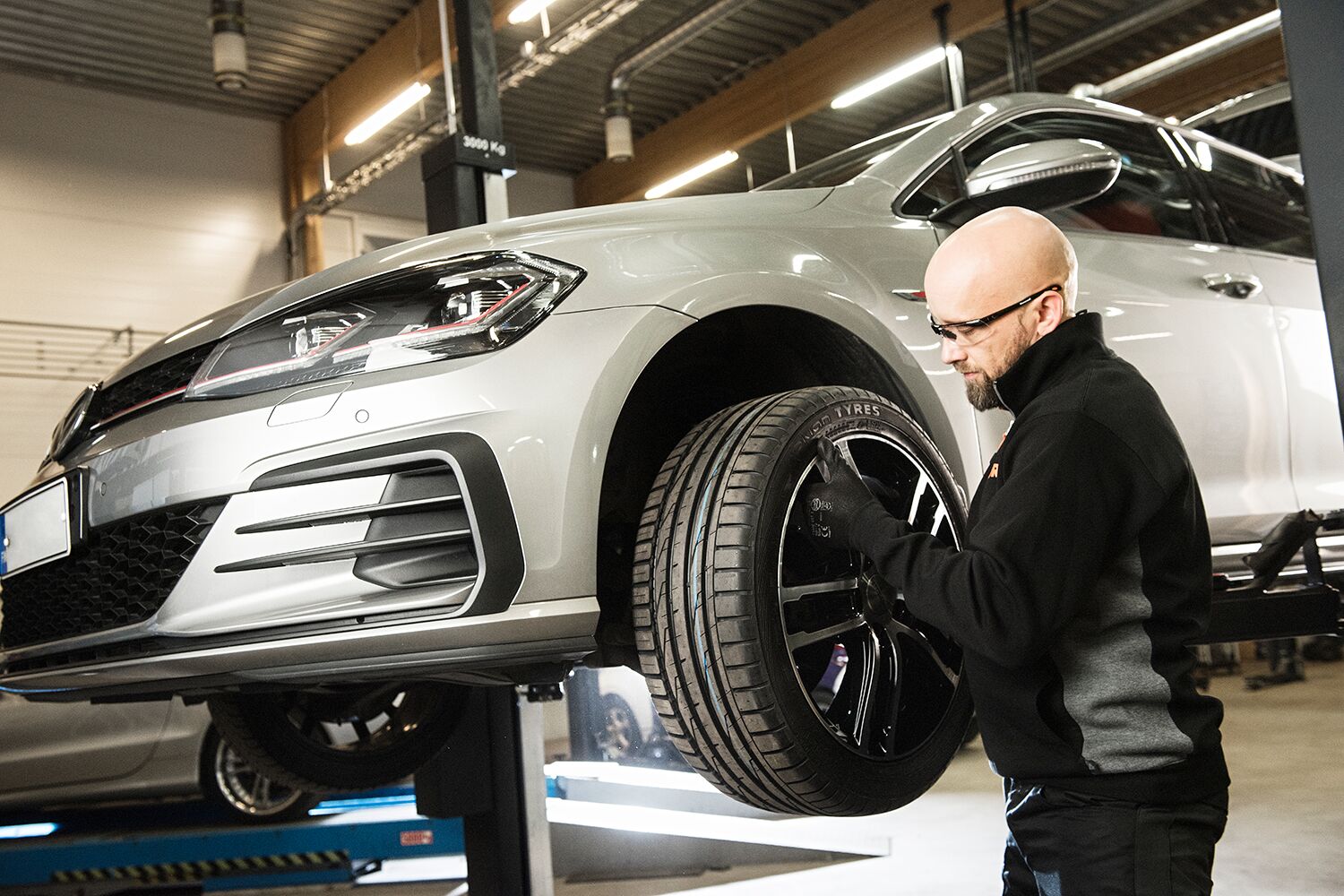
Tire rotation is an essential part of vehicle maintenance. It enhances safety and maximizes tire longevity. Learn how to rotate tires, and why tire rotation matters.
Tires are crucial for safe driving. They connect the vehicle to the road. It's important to maintain your tires properly, and tire rotation is a fundamental part of that. Watch our video on TikTok or here on YouTube Shorts to learn more:
A variety of factors like improper tire pressure or varying weight distribution can cause tires to be put to use disproportionately on the road, resulting in uneven tire wear. This uneven wear is harmful to the tires and the safety of your vehicle's journeys. Combat uneven tire wear with regular tire rotation, which can improve vehicle performance, extend tire lifespan, and enhance safety on the road.
What is tire rotation?
Tire rotation is an important maintenance practice of regularly repositioning tires from one position to another on your vehicle. In most cases, the tires are moved from the front to the rear axle. Typically rotating tires takes around 30–60 minutes. The goal of rotating tires is to ensure even tire wear and prevent premature wear of your tires.
How often to rotate tires?
The frequency of tire rotation can vary based on driving style, the type of vehicle, and how new your tires are, for example. To know when to rotate tires, refer first to your vehicle owner’s manual. If there is no specification about how often you should rotate tires, we recommend getting them rotated every 4,000–6,000 miles (~6,430 - 8,000 kms). When your tires are newer, it's better to have a tire rotation done earlier on (closer to 4,000 miles/~6,430km) - especially on the first rotation. It's good to note that you are rotating tires every time you change to winter tires or mount your all-season tires back on your vehicle.

How to rotate tires?
If you choose to rotate your tires by yourself, here’s how you can do it:
- Consult your vehicle's manual to identify the appropriate tire rotation pattern.
- Loosen the lug nuts on all four tires slightly without removing them.
- Use wheel chocks to secure the tires that will remain on the ground.
- Lift the vehicle using a jack, and place jack stands to support the vehicle. Control the proper placement.
- Follow the recommended rotation pattern and move each tire to its new position.
- Carefully lower the vehicle off the jack stands.
- Tighten the lug nuts diagonally to ensure even and secure fastening.
- Use the manufacturer's specified tightening torque in foot-pounds (ft-lbs), or Nm for metric system users, to tighten the wheels. This information is usually located in the owner’s manual of your vehicle. You can also ask your local tire workshop.
Always double-check that all lug nuts are properly tightened. Remember, proper tire maintenance is essential for your vehicle's safety and performance. Read up about tire balancing here.
If you're unsure about any step, seek assistance from a professional mechanic. You can consult your local Nokian Tyres dealer for recommendations on local mechanics.
Tire rotation patterns
If there are tire rotation pattern recommendations in the vehicle owner’s manual, rotate your tires following them. In case the manufacturer doesn’t provide instructions, here are the most common patterns used for non-directional, same-sized tires:
- Rearward cross pattern. The front tires take opposite rear positions. The rear tires are moved directly forward into the front axle.
- X-pattern. The tires in the front axle are swapped with the opposite rear tires.
- Forward cross pattern. The front tires are moved directly forward into the rear axle. Each rear wheel takes the opposite front position.
There are two additional tire rotation patterns, which are used for high-performance and directional tires:
- Front-to-rear. The tires are rotated between the axles, but without crossing the sides.
- Side-to-side. The tires are crossed from side to side, but without swapping the axles.
Temporary spare tires should not be included in the patterns - they are only for temporary use. However, if the spare tire is a full-size tire, you might want to include it in the pattern.

Why rotate tires?
Tires can wear unevenly due to factors such as improper tire pressure or varying weight distribution and steering forces. Uneven tread wear may lead to issues including compromised handling, reduced traction, and increased risk of blowouts. The same issues can arise when using mismatched tires.
Many tire manufacturers require regular tire rotation to maintain the warranty. In those instances, rotating your tires qualifies you for warranty coverage of your tires. But there are many other important reasons why you should rotate tires regularly:
- Greater tire mileage. When tires wear evenly, you can maximize their longevity and replace them only when truly necessary. Read more about when to replace your tires here.
- Better tire performance. Even tread wear improves steering and braking performance and improves the handling of the vehicle.
- Enhanced safety on the road. Having all four tires in good condition is essential for aiding in safe and secure driving. Rotation helps keep tire condition uniform.
- Cost savings. Uneven wear can lead to increased rolling resistance and fuel consumption. Tire rotation enhances fuel efficiency.
When it is time to buy new tires, we recommend replacing all four tires at the same time. However, since tires on the front axle usually wear faster than rear axle tires, it can occur that only a pair of tires must be replaced. When that happens, make sure to move the partially worn tires to the front axle and mount the better tires on the rear axle. By having a better grip on the rear axle, you have more control of your vehicle, which is particularly important in unexpected situations.
Replace the tires when needed
By practicing regular tire rotation and proper maintenance, you can make your tires last significantly longer, improve road safety, and enhance tire performance. Tires are an essential component of security on the road, so make sure to regularly check their condition. When there is too little tire tread remaining, replace your tires and drive safely, with peace of mind all year round.
Nokian Tyres developed our patented Driving Safety Indicator (DSI) as a safety precaution to help drivers understand and more easily check for themselves how much tread is left on their tires. The numbers on the DSI indicate to you when you have 80%, 60% and 40% tire tread depth remaining. As the tire wears, the numbers gradually wear away. Once your DSI reaches 40%, or if the numbers have worn off completely, you know that it is time to replace your tires.
In the event it's time to replace your tires, contact your local Nokian Tyres dealer for helpful recommendations on what set of Nokian Tyres products will be best suited for your specific driving needs and road conditions.
Please remember that it is the driver’s responsibility to ensure their tires are safe and suitable for their vehicle and to follow the vehicle’s manufacturer´s guidelines for proper use and maintenance. Consult your closest Nokian Tyres dealer or your vehicle’s manufacturer for specific advice.


